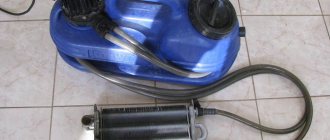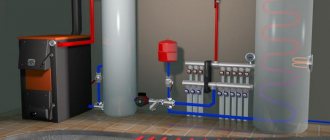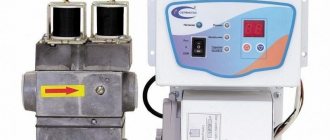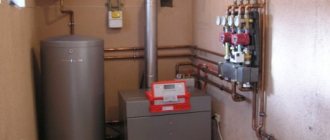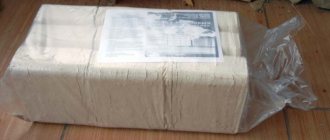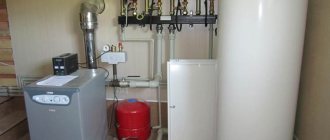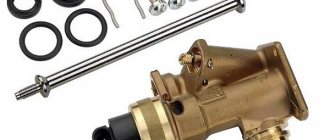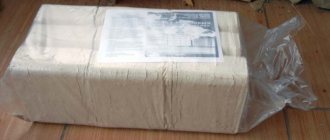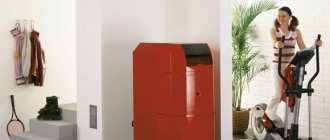Home / Solid fuel boilers
Back
Published: 05/24/2019
Reading time: 7 min
0
2224
In the absence of the opportunity to connect to a centralized gas supply system, the owners of private houses and country houses decide to install an automatic solid fuel boiler.
The fuel used in such units is firewood, coal, peat or sawdust (pellets). But since manual loading of the listed raw materials becomes difficult, many consumers prefer devices with automation of this process.
- 1 Operating principle of automatic long-burning boilers
- 2 Difference from semi-automatic boilers
- 3 Internal structure
- 4 Types of automatic boilers
- 5 Requirements for installation of an automatic solid fuel boiler
- 6 5 best boilers with automatic fuel supply
Types of boilers and burners
Boilers with automatic fuel supply operate on coal or biomass (pellets, oat grains, sunflower husks, wood chips, etc.). Among coal boilers, the most popular boilers are those using “eco-pea” coal as fuel (coal granules with a diameter of 5-25 mm).
To burn fuel in boilers, burners are used: retort, tray or flare. 85% of installed coal boilers with automatic feed operate on retort or tray burners - we will consider these solutions.
Types of automatic boilers
Photo source: steplo-trend.ru
Depending on the type of fuel, automatic long-burning boilers are divided into the following types:
- Powered by pellets.
- Coal heat generators.
- Working on wood chips.
- Universal units.
For the first group, pellets are used as fuel, which are cylindrical granules made from wood waste. Such boilers are universal, since they can be loaded with all kinds of waste, including wood chips, sunflower husks, straw, etc.
The pellet device is fully automated, so human participation in its operation is required no more than 1-2 times every 7 days. At the same time, such heat generators demonstrate the following advantages:
- The maximum percentage of efficiency is up to 90%.
- Full automation. It is provided by an automatic draft regulator for solid fuel boilers.
- Compliance with environmental regulations and standards.
- Cleanliness of operation.
The disadvantages of this option include the high cost of equipment and maintenance, as well as the importance of storing raw materials in a dry building. Otherwise it will get damp.
Coal and wood chip generators operate on a similar principle, as they are equipped with a similar screw mechanism that loads fuel material into the corresponding unit upon command. The differences affect only the design of the screw itself: in coal systems it is larger, which contributes to high efficiency rates.
For smooth operation of coal systems, it is important to select fuel with the correct moisture content and quality. All coal-fired boilers have the option of grinding raw materials, since the loaded wood can have different fractions and lengths. To optimize the size, a special chopping knife is installed between the fuel storage area and the auger. Its operation depends on an electric motor.
There are also universal units that operate on any type of solid fuel. Those. Both coal and wood can be used to heat houses. This possibility is due to the presence of an additional tank for storing and loading logs.
Due to complex execution, the percentage of efficiency is reduced to 80-85%, because The unit operates in solid fuel boiler mode.
Modern manufacturers are trying to make their installations as functional and productive as possible, so some models are able to work even on coal dust and seed husks.
Retort burners
Retort burners consist of a cast iron elbow (retort) and a cast iron grate burner in which the fuel burns. Some burners are equipped with a "ring gear" whose rotation stirs the fuel, breaks down the coking slag, and distributes the fuel throughout the retort tray.
Thanks to the 90-degree bend, the burner is installed in the middle of the combustion chamber, so the side walls of the boiler are heated evenly and do not overheat. The design increases the path to the fuel hopper and reduces the likelihood of fuel fire in the feeder.
Another advantage is low sensitivity to deposits arising in the hearth itself: incoming portions of fresh fuel automatically dump unburnt or sintered fuel into the boiler ash pan.
There is also a downside - bending the knee complicates the supply and combustion of fuel, which eventually settles at the bend. Sediment and carbon deposits build up, reducing the "throat" for fuel movement on its way to the top of the burner. This results in increased resistance of the auger feeder, premature wear of the auger and breakage of the pin (shear bolt) protecting the auger feeder.
Tray burners
Tray burners are a tray made of steel or cast iron into which an auger supplies fuel.
The main advantage of tray burners is their omnivorous nature. The burner burns most types of fuel and fuel mixtures available on the market. Fuel is supplied to the hearth only in a horizontal direction and over a shorter distance compared to a retort burner. The resistance of the feeder during operation of the auger in this case is minimal. At the same time, the short distance of fuel movement and horizontal supply increase the likelihood of fuel backfiring towards the fuel bunker. Therefore, for such structures, additional protection against backfire (fire extinguishing group) is organized.
Another disadvantage is the sensitivity to the formation of sintered substances and deposits in the burner. Deposits accumulate at the end of the burner tray and are more difficult to remove automatically - they will only be removed when the next portion of fuel is fed into the burner.
Reverse heat flow to the bunker (fire)
A rare but familiar accident to manufacturers is the reverse flow of heat to the bunker. In 9 cases out of 10, the situation arises due to the negligence of the boiler user himself. Also, a reverse flow of heat occurs when the safety pin breaks, after which the auger stops rotating.
If the bunker is tightly closed, the fan is running, and nothing prevents the movement of flue gases from the boiler into the chimney, even if the auger does not rotate, there is nothing to fear.
Reverse heat flow (fire) is a rare phenomenon in boilers with automatic fuel supply. However, boiler manufacturers equip supply systems with two safety stages to eliminate such a possibility in principle.
The first stage is a temperature sensor, installed on the fuel supply pipe: if the temperature exceeds the set one, the sensor signals the boiler controller to solve the problem. The controller begins to continuously circulate fuel through the pipe until the sensor temperature returns to normal. The continuous supply interval in Galmet boilers is 10 minutes.
If the problem remains, the thermostatic valve is activated - water is supplied from the emergency tank into the pipe and eliminates the fire in the feeder pipe.
One of the causes of fuel fire in the tank is backdraft, which occurs if the bunker is left open or closed incorrectly. To prevent this from happening, some manufacturers equip the fuel tank lid with a limit switch. When the hopper lid is not closed tightly, the sensor is triggered and gives a warning signal. If measures are not taken, the controller will stop the boiler.
Varieties
When the question arises about choosing suitable equipment for heating a house with solid fuel, the following important points are taken into account: combustion method, material of manufacture and method of coal supply.
All units operate on solid coal.
Combustion type
Thus, a distinction is made between direct and long-burning boilers. Direct or bottom-up combustion is based on the principle of air circulation from the bottom of the combustion chamber. In this case, the fuel begins to burn from below. In the case of long-term combustion, the fuel is burned from above.
The direct combustion mechanism is very simple: the boiler is ignited and coal is manually fed into the chamber. Combustion air enters through the holes (grids) from below - this helps the fire to cover the lower layers of coal well and move it upward. In a long-burning unit, fuel is placed in a chamber and only then is the top layer ignited. Air is supplied from above through a special system.
This combustion method is economical and requires 2 times less loading than in the case of direct combustion.
However, coal-fired units are very picky about the quality of the fuel: it must be dry and slightly caking, and refueling can only be done when the first portion has burned out.
Classification by material
Coal-fired boilers can be made of special boiler steel and cast iron. Steel is not resistant to corrosion and burns out faster, but its maintainability has become an advantage of systems made from this material.
Cast iron, on the contrary, has an impressive service life, resists corrosion, but is also very fragile. This makes it very difficult to repair cast iron boilers and requires replacement of worn parts. Therefore, sometimes these materials are combined during manufacturing. For example, the body is made of steel, and the combustion chamber is made of cast iron.
Classification by delivery method
Boilers are divided into units with classical, semi-automatic and automatic fuel supply. Classic feeding is manual loading into the chamber, which requires the constant presence of the user to maintain the desired temperature. These units are inexpensive, but the high consumption of material and short smoldering time make the benefits minimal.
Semi-automatic boilers are equipped with microprocessors and a fan. All this results in an increase in working time per load with the release of the required amount of heat.
Automatic coal boilers are equipped with a microprocessor fan control system and automatic shutdown sensors when the water temperature is exceeded. There are also built-in control sensors, fire protection valve control, and temperature sensors.
When a signal is received from the temperature sensor, the fuel is automatically filled with water - this eliminates a fire hazard. Fuel consumption is reduced by up to 50%, which in turn reduces the formation of ash by almost 3 times. Therefore, despite the high price, these boilers are very economical and reliable in operation, fully justifying the investment.
What to do to avoid fire?
- Ensure constant boiler draft, hermetically seal the fuel tank and monitor the condition of the fuel tank lid gasket.
- Check the cleanliness of the channel and the air mixer chamber: dust or ash enters the mixing chamber through the blowing nozzles and over time clogs the air supply channel of the fan - as a result, the fuel burns unevenly and the efficiency of the boiler decreases.
- Adjust the fuel supply parameters; if the supply speed is slower than necessary and the air supply to the burner is incorrectly configured, more intense fuel combustion occurs. The result is that combustion begins to move down the burner and goes into the fuel supply pipe.
- The burner metal also heats up and heats the feed tube, resulting in a false alarm indicating reverse heat flow. To avoid false alarms, install a special non-flammable gasket separating the burner and the pipe - the gasket will not allow the temperature of the heated burner to be transferred to the feeder pipe.
Smoke from the fuel tank.
There is a simple “at-home” way to check the quality of smoke removal from the boiler: open the boiler door - if adjusted correctly, smoke does not come out, even if all doors are open.
If exhaust gases (smoke) come out of the fuel tank, this is a sign of insufficient chimney draft. This happens when the boiler chimney or the incoming combustion air mixer is clogged. The second reason is incorrect boiler control settings or a simply unsuccessful boiler design.
Another note: when adding fuel to the firebox, make sure that the burner is at rest (the fan is turned off and does not create excess pressure in the boiler).
Broken pin (shear bolt): causes.
A common reason for the boiler to stop working is the pin (shear bolt) that connects the engine to the auger breaks. Below are possible reasons for this failure:
- Fuel of non-recommended fraction
- Foreign bodies in fuel (bolt, stone, pieces of wire)
- Deposits (carbon deposits) in a retort-type burner - carbon deposits reduce the diameter of the channel for fuel supply to the burner and increase the resistance of the screw. The problem is easily identified: when carbon deposits are deposited on the retort elbow, the “crunching” sound when fuel is supplied to the burner becomes louder. Once a year, before the start of the heating season, clean the fuel supply elbow to the burner. If the boiler runs on pellets, it is better to repeat the procedure during the season - when using pellets, carbon deposits form faster.
- Damage to the auger. Over time, the auger turns wear out mechanically or are destroyed by sulfur contained in the fuel. In places of wear, the auger does not move fuel but grinds it. Sawdust or coal chips accumulate in the feed tube, increasing the resistance of the auger. The wear rate of the auger depends on the humidity of the fuel used, the sulfur content in the fuel and the location of the boiler room (in a damp basement and without ventilation, the service life of the equipment is reduced).
- Incorrect installation of the boiler (the adjustable foot of the fuel tank is used to adjust the height and leveling of the boiler supply system).
| IMPORTANT! When transporting the boiler, do not lift the structure by the screw feeder pipe: if the load is distributed incorrectly, the pipe is deformed and the geometry of the feed system is disrupted. The result: additional noise when the auger rotates, its premature wear and constant pin failures. |
Operating principle of automatic coal boiler
The operating principle of such a boiler is based on the automated supply of fuel, in our case coal, into the combustion chamber. And as a result, the design of such a boiler must contain, at a minimum, a mechanism for supplying fuel to the combustion area and a place for its storage. The first distinctive features of an automatic boiler are responsible for this - the feeding mechanism itself, and depending on the fraction and quality of the coal, it can be different (see screw feed and piston feed), as well as the fuel bunker, which stores a certain supply of coal, enough which on average lasts 3-7 days of continuous operation.
To ensure the required intensity and completeness of coal combustion, the automatic boiler is equipped with one or two (depending on the model and power) forced-air fans, the rotation speed of which, as well as the frequency of coal supply to the burner, is controlled by the microprocessor controller mentioned above - a kind of brain of the entire heating system of the house, without which no automatic heating boiler can do.
As a result, at the same time, a strictly calculated amount of fuel burns in a thin layer on the burner - the final necessary element of an automatic boiler, after which, after the next signal from the controller, the feed mechanism supplies the combustion zone with a new portion of coal. It is thanks to a balanced approach to the simultaneous supply of a small amount of fuel that complete combustion and high operating efficiency of an automatic coal boiler are achieved.
It is worth noting that, as in the case of the feed mechanism, each type of coal fuel has its own burner. For automatic coal boilers, for which it is supposed to use eco-pea coal (5-25 mm) as the main fuel, this is a retort burner. For boilers that will use “eco-peas” (5-25 mm) with a high (up to 60%) content of coal (fine coal) as the main fuel, this is an AKM type burner.
You can put together the information received and present the overall picture of the operation of an automatic boiler quite easily by watching a short information video once:
Electronics defects
In the boiler room, in addition to the boiler itself, auxiliary equipment is installed that controls the operation of the system: circulation pumps and hot water pumps, valves and distribution manifolds, safety group electronics. Random errors in the operation of equipment lead to malfunctions of the boiler controller. Factory malfunctions of the equipment are also possible - the manufacturer accepts it as acceptable if for every 1000 products 30-50 controllers work with errors after launch.
When connecting devices, surprises also happen: a short circuit of the triac - transistor of the fuel supply system or fan motor causes continuous operation of the feeder (auger) or fan. If the fan or auger is constantly running, the boiler controller generates an error signal and turns off.
Even if connected incorrectly, it is possible to damage the connector that connects the pump power to the controller. This is unpleasant, but not fatal: in this case, the pump is connected directly to the outlet.
Sometimes a boiler is purchased in advance, and then it waits in the boiler room for installation. The boiler is tightly closed with a bag or film: when temperature changes, condensation forms, including on the controller elements, which then fail. If you purchase the boiler in advance, prepare a suitable storage place - dry and warm with free access of air to the controller.
Manual boilers with automation
To operate this boiler, it is necessary to place coal on the burnt layer. You can regulate heat transfer by opening and closing the damper. All actions will have to be carried out manually.
Manual boilers with automation have several advantages:
- You can use different types of coal and firewood;
- Low cost of equipment;
- Easy to use;
- Lightness of the device.
But it is also worth highlighting some disadvantages:
- Frequency of adding coal or firewood;
- High fuel consumption and low heat transfer;
When using a thermostat, you can control the degree to which the damper rises when the temperature changes. Complex level boilers have a thermometer and a fan, and they can be controlled using a conventional regulator.
Aging of boiler elements
Check your boiler periodically to ensure safe and trouble-free operation in the upcoming heating season. In boilers with a screw mechanism, the feeder is damaged within 2 years: it is worn out or corroded due to exposure to sulfur and moisture. If the boiler runs on low-sulfur fuel (pellets or oat grains), the corrosion process will be minimal. But when coal is burned, the moisture in the fuel accelerates corrosion of the auger.
By carefully lubricating the connections and rubbing elements of the fuel supply device, it is possible to increase the service life of the feeder up to 10 years. And if you need to remove the auger from the feeder for maintenance or repair, this will be easier to do.
And it’s not only easier, but also safer; without lubrication, the auger “sours.” To dismantle it, you will have to knock the auger out of the mounting hole, risking damage to the gearbox, which costs much more.
Clean the heat exchanger thoroughly after the end of the heating season. During the period when the boiler is not in operation, the boiler heat exchanger must be constantly ventilated: to do this, open the boiler doors and check the flow of fresh air into the boiler room.
The connection between the boiler and the chimney also corrodes and leads to leakage of combustion products (flue gases), reducing the efficiency of the boiler. To avoid leakage of flue gases from the boiler, monitor the quality of the sealing gaskets at the joints.
Once every 2-3 years, replace the fuel supply motor and fan. If this is not possible, disassemble and clean the blades of the fan impeller: dirty blades reduce the quality of the fan, reduce the capacitance of the condenser and cause axial runout of the rotor, which eventually disables the fan.
Fuel supply in the boiler room
The supply of fuel to a boiler room is one of the most important stages in the functioning of the entire boiler room, and the productivity and efficiency of work directly depends on its proper organization. The type of boiler room and the nature of the fuel supply depend on the type of fuel on which the boiler operates.
Fuel supply in a coal boiler house
A solid fuel boiler house can operate on coal, peat, firewood, as well as waste from the woodworking industry and agriculture in bulk and compressed in the form of briquettes and pellets.
The supply of fuel in a solid fuel boiler room begins from its reception points, where it is delivered by road and rail. Next, the fuel is transported to storage areas. Basically, fuel warehouses are open; closed warehouses are used for wood fuel, as well as in residential areas or at the request of regulatory authorities. The size of coal stacks is not limited. Peat stacks should have a length of no more than 125 meters, a width of no more than 30 meters, a height of no more than 7 meters, and the angle of repose of the stacks is 40-60°.
Unloading and loading operations in warehouses and transportation of fuel to boiler rooms are carried out using mechanisms. These can be bulldozers, loaders, grab and scraper installations and conveyors. Belt conveyors have a lifting angle from 12 to 18 degrees. Fuel from the receiving bunkers is transported to the loading (or boiler) bunker, from where it enters the combustion device.
Fuel supply to the boiler can be manual, mechanized and automated. Cast iron sectional boilers, steel hot water boilers of the KVR brand, some types of block-modular boiler houses with manual combustion have a loading door, and fuel is loaded through it manually.
Mechanized fuel supply in the boiler room is carried out in KVM boilers with mechanical fireboxes of various types. Fuel is supplied to the receiving hopper of the boiler, as well as to the loading (boiler) hopper by conveyors or a skip device. Conveyors are divided into belt, scraper and screw. The driving force that moves fuel in a conveyor belt is an endlessly moving belt onto which the fuel is loaded. The tape is made of rubberized cotton fabric and covered with an additional layer of rubber on top. Its speed of movement is from 1.5 to 2 m/sec, width from 30 to 100 cm, length, if necessary, up to 70 m. Fuel can move horizontally and with crushed coal rising by 18°, uncrushed lump coal up to 12°.
A scraper conveyor moves fuel along a stationary belt by capturing it with scrapers. It is constructed of separate, interconnected straight and rotary sections. Using various combinations of sections, the conveyor can move fuel at an angle of up to 36° and with an elevation of 45°.
Screw conveyors also move fuel along a stationary belt using a moving screw. Such conveyors are widely used in block-modular boiler houses to deliver fuel to the boiler bunker.
Depending on the grade of solid fuel, crushers are installed before the loading hopper, crushing the fuel to the required size.
The boiler bunker must have a smooth internal surface, the corners must be smoothed or rounded for unhindered fuel flow. The angle of inclination of the walls should be 60° for coal, 65° for peat. In addition, bins must have anti-jam devices. In the boiler firebox, fuel can flow by gravity onto a moving grate (TLPKh fireboxes) using a thrower (ZP RPK, TLZM fireboxes), using a screwing strip (TSHPH firebox).
When burned in chamber furnaces, solid fuel undergoes additional processing. It is ground, dried and fed as dust into the combustion chamber of the furnace.
Fuel supply in a gas boiler room
Both modular and stationary boiler houses operate on gas fuel (natural, associated, liquefied gas). Gas is burned in chamber furnaces, and all processes in gas boiler houses are automated. Fuel supply in a boiler house operating on gaseous fuel is carried out for all boiler houses of the second category through one gas pipeline, for boiler houses of the first category - through two gas pipelines.
To maintain the required pressure in gas pipelines, gas control units (GRU) are installed in the boiler house building itself or gas control points (GRP) on the territory. When laying gas pipelines, a slope of at least 0.003 along the gas flow must be maintained. Gas pipelines should not be laid below the zero mark, they should not have any additional load. When entering the boiler room, it is necessary to install a gas supply shutoff device at a height of no more than 1.8 meters.
The boiler house building is equipped with shut-off valves and a valve at the outlet to the boiler and burner. In case of an emergency, a container with liquefied gas and devices for heating and spraying it into the boiler must be provided on the gas pipeline. Entering the boiler furnace through the burner device, the gas ignites and heats the coolant.
Fuel supply in a liquid fuel boiler room
Fuel supply in a liquid fuel boiler room is also carried out in an automated mode. The fuel can be oil, diesel fuel, fuel oil, waste oils. Boiler houses generally operate on fuel oil or light oil. The supply of liquid fuel is delivered by rail and supplied to drainage devices. The tank for receiving fuel must be above ground with a coating; underground tanks are allowed for fuel oil.
For fuel storage, there are two main tanks and one reserve tank. Liquid fuel must be heated in tanks. The temperature for fuel oil is 60-80 °C, for light oil fuel - 10 °C. The supply of fuel oil to the boiler room is provided according to a circulation circuit, light oil - through a dead-end circuit. From the tanks, fuel is supplied to the boiler room via overhead fuel pipelines with a slope of 0.003 in the direction of fuel movement. Fuel pipelines must have the same thermal insulation as the heating pipelines.
Liquid fuel is supplied to the boilers using pumps; there must be at least two of them. Fuel is supplied to the boilers via two lines for category 1 boilers or one line for category 2 boilers. Before the pumping equipment, the fuel must be filtered through coarse filters, and before the burners - through fine filters. To collect drainage, a drainage tank is installed outside the boiler room. Fuel pipelines in the boiler room must have thermal insulation made of non-combustible materials, their design must be open and have free access. Fuel pipes, depending on the pressure, can be seamless or electric-welded, and the fittings can be steel. It is also necessary to provide shut-off valves at the outlets to the boiler and drain line and at the nozzle. Steam and rotary nozzles are used to atomize fuel. Boiler houses may have equipment for switching from one type of fuel to another.

